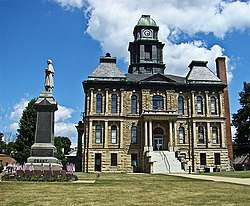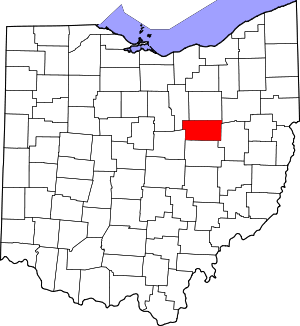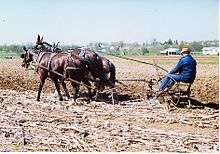Holmes County, Ohio
Holmes County is a county located in the U.S. state of Ohio. As of the 2010 census, the population was 42,366.[1] Its county seat is Millersburg.[2] The county was formed in 1824 from portions of Coshocton, Tuscarawas and Wayne counties and organized the following year.[3] It was named after Andrew Holmes, an officer killed in the War of 1812.[4]
Holmes County | |
|---|---|
 Holmes County Courthouse, with the Grant Memorial Statue | |
 Seal | |
 Location within the U.S. state of Ohio | |
 Ohio's location within the U.S. | |
| Coordinates: 40°34′N 81°56′W | |
| Country | |
| State | |
| Founded | January 4, 1825 |
| Named for | Andrew Holmes |
| Seat | Millersburg |
| Largest village | Millersburg |
| Area | |
| • Total | 424 sq mi (1,100 km2) |
| • Land | 423 sq mi (1,100 km2) |
| • Water | 1.4 sq mi (4 km2) 0.3%% |
| Population | |
| • Estimate (2019) | 43,960 |
| • Density | 100/sq mi (40/km2) |
| Time zone | UTC−5 (Eastern) |
| • Summer (DST) | UTC−4 (EDT) |
| Congressional district | 7th |
| Website | www |
Holmes County, which was about 42% Amish in 2010,[5] is home to the second largest Amish community (after Lancaster County, Pennsylvania) in the world,[6] which draws many visitors to the county.
History
Holmes County was formed on January 20, 1824 from portions of Coshocton, Tuscarawas and Wayne counties. It was named after Andrew Holmes, an officer in the War of 1812. In 1863, during the Civil War, numerous small anti-draft riots took place, mainly in the German-speaking areas. Holmes County at the time was a Democratic stronghold, dominated by its Pennsylvania Dutch settlers, along with many recent German immigrants. With the passage of the Conscription Act in March 1863, Holmes County politicians denounced both Congress and President Lincoln as despotic, saying that forced military service was little different than slavery. Conscription had been common in their former German homelands, and it was one of the reasons they had moved to America. Violent protests broke out in June, and they continued until the Union Army marched into the county and declared martial law.[7]
Geography
According to the U.S. Census Bureau, the county has a total area of 424 square miles (1,100 km2), of which 423 square miles (1,100 km2) is land and 1.4 square miles (3.6 km2) (0.3%) is water.[8]
Adjacent counties
- Wayne County (north)
- Stark County (northeast)
- Tuscarawas County (east)
- Coshocton County (south)
- Knox County (southwest)
- Ashland County (northwest)
Demographics
| Historical population | |||
|---|---|---|---|
| Census | Pop. | %± | |
| 1830 | 9,135 | — | |
| 1840 | 18,088 | 98.0% | |
| 1850 | 20,452 | 13.1% | |
| 1860 | 20,589 | 0.7% | |
| 1870 | 18,177 | −11.7% | |
| 1880 | 20,776 | 14.3% | |
| 1890 | 21,139 | 1.7% | |
| 1900 | 19,511 | −7.7% | |
| 1910 | 17,909 | −8.2% | |
| 1920 | 16,965 | −5.3% | |
| 1930 | 16,726 | −1.4% | |
| 1940 | 17,876 | 6.9% | |
| 1950 | 18,760 | 4.9% | |
| 1960 | 21,591 | 15.1% | |
| 1970 | 23,024 | 6.6% | |
| 1980 | 29,416 | 27.8% | |
| 1990 | 32,849 | 11.7% | |
| 2000 | 38,943 | 18.6% | |
| 2010 | 42,366 | 8.8% | |
| Est. 2019 | 43,960 | [9] | 3.8% |
| U.S. Decennial Census[10] 1790-1960[11] 1900-1990[12] 1990-2000[13] 2010-2019[1] | |||

2000 census
As of the census[14] of 2000, there were 38,943 people, 11,337 households, and 9,194 families living in the county. The population density was 92 people per square mile (36/km²). There were 12,280 housing units at an average density of 29 per square mile (11/km²). The racial makeup of the county was 99.03% White, 0.33% Black or African American, 0.06% Native American, 0.06% Asian, 0.01% Pacific Islander, 0.13% from other races, and 0.40% from two or more races. Hispanic or Latino of any race were 0.75% of the population. 56.1% spoke English, 20.1% Pennsylvania German, 15.8% German and 7.1% "Dutch, i.e. Pennsylvania Dutch."[15] as their first language.
There were 11,337 households out of which 44.30% had children under the age of 18 living with them, 71.50% were married couples living together, 6.50% had a female householder with no husband present, and 18.90% were non-families. 16.10% of all households were made up of individuals and 6.90% had someone living alone who was 65 years of age or older. The average household size was 3.35 and the average family size was 3.82. Religious breakdown for those who gave a religion (68.33 of the total population) was 89.79% Evangelical Protestant, 8.04% Mainline Protestant and 2.16% Catholic. There were 140 Amish congregations with 17,654 adherents. There were several other unrelated Amish congregations and Mennonite congregations. There was one Catholic congregation.[16]
In the county, the population was spread out with 35.60% under the age of 18, 10.40% from 18 to 24, 25.70% from 25 to 44, 17.80% from 45 to 64, and 10.50% who were 65 years of age or older. The median age was 28 years. For every 100 females there were 99.60 males. For every 100 females age 18 and over, there were 95.50 males.
The median income for a household in the county was $36,944, and the median income for a family was $40,230. Males had a median income of $28,490 versus $20,602 for females. The per capita income for the county was $14,197. About 10.50% of families and 12.90% of the population were below the poverty line, including 17.40% of those under age 18 and 13.30% of those age 65 or over.
Holmes County has a relatively high number of residents who do not speak English at home. According to the 2000 census, almost 36% of the population speak either Pennsylvania German or German at home, and a further 7% speak "Dutch", i.e. Pennsylvania Dutch.[15] 42.92% of the total population and 50.28% of the children in 5-17 age range uses German/Pennsylvania German or "Dutch"[15] at home.[17]
2010 census
As of the 2010 United States Census, there were 42,366 people, 12,554 households, and 10,035 families living in the county.[18] The population density was 100.3 inhabitants per square mile (38.7/km2). There were 13,666 housing units at an average density of 32.3 per square mile (12.5/km2).[19] The racial makeup of the county was 98.7% white, 0.3% black or African American, 0.1% Asian, 0.1% American Indian, 0.2% from other races, and 0.5% from two or more races. Those of Hispanic or Latino origin made up 0.8% of the population.[18] In terms of ancestry, 37.8% were German, 10.8% were American, 6.6% were Irish, and 6.3% were English.[20]
Of the 12,554 households, 42.9% had children under the age of 18 living with them, 69.7% were married couples living together, 6.9% had a female householder with no husband present, 20.1% were non-families, and 17.2% of all households were made up of individuals. The average household size was 3.31 and the average family size was 3.80. The median age was 29.7 years.[18]
The median income for a household in the county was $43,533 and the median income for a family was $49,133. Males had a median income of $36,644 versus $24,317 for females. The per capita income for the county was $17,009. About 10.5% of families and 13.3% of the population were below the poverty line, including 18.9% of those under age 18 and 6.9% of those age 65 or over.[21]
Politics
Prior to 1944, Holmes County was Democratic Party stronghold in presidential elections, with every Democratic presidential candidate from 1856 to 1940 aside from Al Smith in 1928 managing to win the county. The county has since become a Republican Party stronghold, with Lyndon B. Johnson in 1964 the lone Democrat since 1940 to win the county in a presidential election, but Harry S. Truman came within just 16 votes of winning it in 1948.
| Year | Republican | Democratic | Third parties |
|---|---|---|---|
| 2016 | 78.5% 8,720 | 16.1% 1,788 | 5.4% 598 |
| 2012 | 75.2% 8,702 | 22.6% 2,608 | 2.2% 257 |
| 2008 | 69.3% 7,720 | 28.2% 3,141 | 2.5% 273 |
| 2004 | 75.5% 8,468 | 24.0% 2,697 | 0.5% 55 |
| 2000 | 73.9% 6,754 | 22.6% 2,066 | 3.6% 325 |
| 1996 | 57.4% 5,213 | 27.9% 2,531 | 14.8% 1,340 |
| 1992 | 56.1% 5,079 | 21.7% 1,969 | 22.2% 2,008 |
| 1988 | 69.2% 5,064 | 29.8% 2,179 | 1.0% 73 |
| 1984 | 74.1% 5,146 | 25.0% 1,737 | 0.9% 61 |
| 1980 | 60.4% 3,860 | 32.8% 2,094 | 6.9% 440 |
| 1976 | 54.2% 2,870 | 42.3% 2,242 | 3.5% 187 |
| 1972 | 70.0% 3,752 | 28.1% 1,507 | 1.9% 103 |
| 1968 | 58.5% 3,350 | 33.1% 1,898 | 8.4% 481 |
| 1964 | 37.2% 2,106 | 62.8% 3,559 | |
| 1960 | 69.4% 4,432 | 30.6% 1,953 | |
| 1956 | 68.8% 3,955 | 31.2% 1,795 | |
| 1952 | 65.1% 3,891 | 34.9% 2,089 | |
| 1948 | 50.1% 2,496 | 49.8% 2,480 | 0.1% 6 |
| 1944 | 54.7% 3,093 | 45.3% 2,563 | |
| 1940 | 48.9% 3,201 | 51.1% 3,349 | |
| 1936 | 34.9% 2,247 | 63.7% 4,097 | 1.4% 88 |
| 1932 | 31.6% 1,953 | 66.3% 4,096 | 2.1% 131 |
| 1928 | 67.4% 3,457 | 31.8% 1,631 | 0.8% 39 |
| 1924 | 38.3% 1,824 | 53.3% 2,539 | 8.5% 405 |
| 1920 | 38.8% 2,065 | 60.3% 3,211 | 0.9% 49 |
| 1916 | 24.7% 955 | 73.6% 2,846 | 1.7% 64 |
| 1912 | 12.8% 465 | 66.9% 2,429 | 20.3% 737 |
| 1908 | 28.7% 1,252 | 69.8% 3,043 | 1.4% 62 |
| 1904 | 34.8% 1,377 | 62.8% 2,486 | 2.5% 97 |
| 1900 | 26.8% 1,269 | 71.8% 3,394 | 1.4% 67 |
| 1896 | 25.9% 1,284 | 73.2% 3,622 | 0.9% 45 |
| 1892 | 25.6% 1,152 | 69.9% 3,151 | 4.5% 204 |
| 1888 | 25.8% 1,241 | 70.5% 3,388 | 3.7% 180 |
| 1884 | 28.6% 1,366 | 70.4% 3,368 | 1.0% 48 |
| 1880 | 29.4% 1,370 | 70.3% 3,281 | 0.3% 16 |
| 1876 | 28.1% 1,241 | 71.8% 3,171 | 0.1% 2 |
| 1872 | 30.1% 1,089 | 69.9% 2,530 | 0.0% 1 |
| 1868 | 27.4% 1,083 | 72.5% 2,859 | |
| 1864 | 28.4% 1,066 | 71.5% 2,681 | |
| 1860 | 37.4% 1,392 | 61.3% 2,281 | 1.2% 48 |
| 1856 | 37.8% 1,285 | 61.9% 2,103 | 0.1% 5 |
Communities

| Township | Village | Other places in township |
|---|---|---|
| Berlin | Berlin (CDP) | |
| Clark | Baltic (north part) | Charm (UIC) Farmerstown (UIC) Unionville (UIC) |
| Hardy | Millersburg (county seat) | Holmes County Airport |
| Killbuck | Killbuck | |
| Knox | Nashville (south part) | |
| Mechanic | Lake Buckhorn (CDP) Becks Mills Saltillo | |
| Monroe | Welcome (UIC) West Holmes High School | |
| Paint | Winesburg (CDP) | |
| Prairie | Holmesville | |
| Richland | Glenmont | Stillwell |
| Ripley | Big Prairie (UIC) | |
| Salt Creek | Mt. Hope (UIC) | |
| Walnut Creek | Walnut Creek (CDP) Trail (UIC) | |
| Washington | Loudonville (east part) Nashville (north part) | Lakeville (UIC) |
CDP = Census-designated place
UIC = Unincorporated community
https://web.archive.org/web/20160715023447/http://www.ohiotownships.org/township-websites
Transportation
Holmes County Airport (FAA LID: 10G) located two miles southwest of Millersburg.
Amish community
A large Amish community of about 36,000 exists in Northeast-Central Ohio, centered on Holmes County and extending into surrounding counties.[24] The Holmes Old Order Amish affiliation with 140 church districts out of 221 in the Holmes County Amish settlement in 2009 is the main and dominant Amish affiliation.[25] Holmes County houses the highest percentage of Amish of any U.S. county, currently 42 percent of the population, and experts speculate that within -15 years Holmes County may be the first majority Amish county.[26] The Amish & Mennonite Heritage Center in Berlin explains traditional ways of the Amish and provides an illustrated history for visitors in its 10-foot-by-265-foot mural.[27]
The overall Amish population of the area, centered on Holmes County, is the largest Amish community in the world.[24] Called locally "Amish Country", it draws many visitors to the county, thus making tourism an important sector of the local economy.
In Holmes County Amish Settlements there are several Old Order Amish affiliations. The Holmes Old Order Amish affiliation is the main and original affiliation, the Swartzentruber Amish with three subgroups, that originated in 1917 in Holmes County, are the most conservative Amish in Holmes county. There are also Andy Weaver Amish (formed 1952), Stutzman-Troyer Amish, Old Order Tobe Amish and Roman Amish on the conservative side, whereas the New Order Amish (formed in the early 1960s), the New Order Tobe Amish the New Order Amish Christian Fellowship are on the more progressive side. Holmes County is home of more Amish affiliations than any other place in the world.[28][29]
See also
| Wikimedia Commons has media related to Holmes County, Ohio. |
References
- "State & County QuickFacts". United States Census Bureau. Archived from the original on June 29, 2011. Retrieved February 8, 2015.
- "Find a County". National Association of Counties. Archived from the original on 2011-05-31. Retrieved 2011-06-07.
- "Ohio: Individual County Chronologies". Ohio Atlas of Historical County Boundaries. The Newberry Library. 2007. Retrieved February 14, 2015.
- Gannett, Henry (1905). The Origin of Certain Place Names in the United States. Govt. Print. Off. pp. 159.
- Amish Groups, undifferentiated Counties (2010) at The Association of Religion Data Archives.
- Twelve Largest Settlements at Amish Studies
- Kenneth H. Wheeler, "Local autonomy and civil war draft resistance: Holmes County, Ohio," Civil War History, June 1999, Vol. 45 Issue 2, pp 147-58
- "2010 Census Gazetteer Files". United States Census Bureau. August 22, 2012. Archived from the original on May 4, 2014. Retrieved February 8, 2015.
- "Population and Housing Unit Estimates". Retrieved March 26, 2020.
- "U.S. Decennial Census". United States Census Bureau. Retrieved February 8, 2015.
- "Historical Census Browser". University of Virginia Library. Retrieved February 8, 2015.
- Forstall, Richard L., ed. (March 27, 1995). "Population of Counties by Decennial Census: 1900 to 1990". United States Census Bureau. Retrieved February 8, 2015.
- "Census 2000 PHC-T-4. Ranking Tables for Counties: 1990 and 2000" (PDF). United States Census Bureau. April 2, 2001. Retrieved February 8, 2015.
- "U.S. Census website". United States Census Bureau. Retrieved 2008-01-31.
- It is likely that those reporting such confused Pennylvania Dutch, a German dialect, with Dutch.
- http://www.thearda.com/rcms2010/r/c/39/rcms2010_39075_county_name_2010.asp
- http://www.mla.org/map_data_results&state_id=39&county_id=75&mode=geographic&zip=&place_id=&cty_id=&ll=&a=&ea=&order=r
- "DP-1 Profile of General Population and Housing Characteristics: 2010 Demographic Profile Data". United States Census Bureau. Archived from the original on 2020-02-13. Retrieved 2015-12-27.
- "Population, Housing Units, Area, and Density: 2010 - County". United States Census Bureau. Archived from the original on 2020-02-13. Retrieved 2015-12-27.
- "DP02 SELECTED SOCIAL CHARACTERISTICS IN THE UNITED STATES – 2006-2010 American Community Survey 5-Year Estimates". United States Census Bureau. Archived from the original on 2020-02-13. Retrieved 2015-12-27.
- "DP03 SELECTED ECONOMIC CHARACTERISTICS – 2006-2010 American Community Survey 5-Year Estimates". United States Census Bureau. Archived from the original on 2020-02-13. Retrieved 2015-12-27.
- The 12 Largest Amish Communities (2017). at Amish America
- Leip, David. "Dave Leip's Atlas of U.S. Presidential Elections". uselectionatlas.org. Retrieved 2018-05-02.
- "Fact Sheets: Holmes County and Amish Country". Holmes County Chamber of Commerce. Retrieved July 29, 2012.. Quote: "Approximately 36,000 Amish residents make the region the largest Amish community in the world. Centered in Holmes County, Amish Country extends into each of the surrounding five counties. The Amish community has existed in this region of Ohio since 1809."
- Charles E. Hurst, David L. McConnell: An Amish Paradox: Diversity and Change in the World's Largest Amish Community, Baltimore 2010, pages 35-36
- "Estimate: A New Amish Community is Founded Every 3 1/2 Weeks in U.S." The Ohio State University. Archived from the original on 2013-06-02. Retrieved 2013-06-17.. Quote: "“My guess is that in 15 years, we'll witness a county whose population is majority Amish, and Holmes County is likely to gain that distinction first. Perhaps LaGrange County in Indiana will not be far behind,” Donnermeyer said."
- amishcountryinsider.com/amish-mennonite-heritage-center
- Charles E. Hurst, David L. McConnell: An Amish Paradox: Diversity and Change in the World's Largest Amish Community, Baltimore 2010, page 36.
- Ohio Amish: The Holmes County Amish settlement at http://amishamerica.com
External links
| Wikivoyage has a travel guide for Holmes County (Ohio). |
.svg.png)